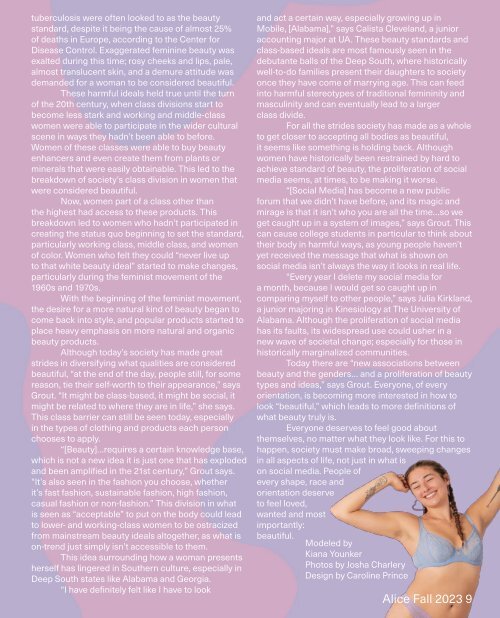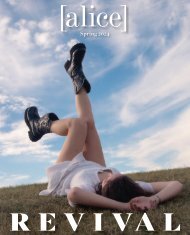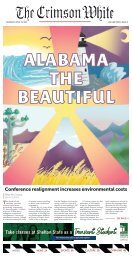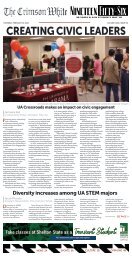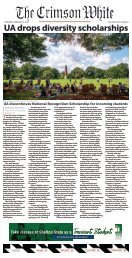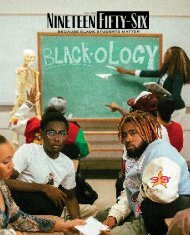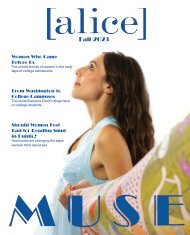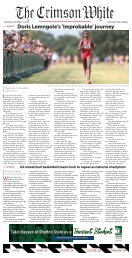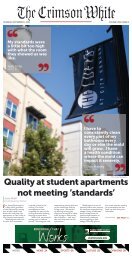Volume 9 Issue 1
The first issue of Volume 9 spotlights women, both past and present, who are leaving their mark through creativity. From historical women who blazed trails before us, to Supreme Court decisions that shape the lives of college students, and even the unapologetic act of reading smut in public spaces. Volume 9 Issue 1 is a tapestry that weaves together the threads of the past, present, and future, celebrating the power of artistic expression to provoke thought, challenge norms and ignite change.
The first issue of Volume 9 spotlights women, both past and present, who are leaving their mark through creativity. From historical women who blazed trails before us, to Supreme Court decisions that shape the lives of college students, and even the unapologetic act of reading smut in public spaces. Volume 9 Issue 1 is a tapestry that weaves together the threads of the past, present, and future, celebrating the power of artistic expression to provoke thought, challenge norms and ignite change.
You also want an ePaper? Increase the reach of your titles
YUMPU automatically turns print PDFs into web optimized ePapers that Google loves.
tuberculosis were often looked to as the beauty<br />
standard, despite it being the cause of almost 25%<br />
of deaths in Europe, according to the Center for<br />
Disease Control. Exaggerated feminine beauty was<br />
exalted during this time; rosy cheeks and lips, pale,<br />
almost translucent skin, and a demure attitude was<br />
demanded for a woman to be considered beautiful.<br />
These harmful ideals held true until the turn<br />
of the 20th century, when class divisions start to<br />
become less stark and working and middle-class<br />
women were able to participate in the wider cultural<br />
scene in ways they hadn’t been able to before.<br />
Women of these classes were able to buy beauty<br />
enhancers and even create them from plants or<br />
minerals that were easily obtainable. This led to the<br />
breakdown of society’s class division in women that<br />
were considered beautiful.<br />
Now, women part of a class other than<br />
the highest had access to these products. This<br />
breakdown led to women who hadn’t participated in<br />
creating the status quo beginning to set the standard,<br />
particularly working class, middle class, and women<br />
of color. Women who felt they could “never live up<br />
to that white beauty ideal” started to make changes,<br />
particularly during the feminist movement of the<br />
1960s and 1970s.<br />
With the beginning of the feminist movement,<br />
the desire for a more natural kind of beauty began to<br />
come back into style, and popular products started to<br />
place heavy emphasis on more natural and organic<br />
beauty products.<br />
Although today’s society has made great<br />
strides in diversifying what qualities are considered<br />
beautiful, “at the end of the day, people still, for some<br />
reason, tie their self-worth to their appearance,” says<br />
Grout. “It might be class-based, it might be social, it<br />
might be related to where they are in life,” she says.<br />
This class barrier can still be seen today, especially<br />
in the types of clothing and products each person<br />
chooses to apply.<br />
“[Beauty]…requires a certain knowledge base,<br />
which is not a new idea it is just one that has exploded<br />
and been amplified in the 21st century,” Grout says.<br />
“It’s also seen in the fashion you choose, whether<br />
it’s fast fashion, sustainable fashion, high fashion,<br />
casual fashion or non-fashion.” This division in what<br />
is seen as “acceptable” to put on the body could lead<br />
to lower- and working-class women to be ostracized<br />
from mainstream beauty ideals altogether, as what is<br />
on-trend just simply isn’t accessible to them.<br />
This idea surrounding how a woman presents<br />
herself has lingered in Southern culture, especially in<br />
Deep South states like Alabama and Georgia.<br />
“I have definitely felt like I have to look<br />
and act a certain way, especially growing up in<br />
Mobile, [Alabama],” says Calista Cleveland, a junior<br />
accounting major at UA. These beauty standards and<br />
class-based ideals are most famously seen in the<br />
debutante balls of the Deep South, where historically<br />
well-to-do families present their daughters to society<br />
once they have come of marrying age. This can feed<br />
into harmful stereotypes of traditional femininity and<br />
masculinity and can eventually lead to a larger<br />
class divide.<br />
For all the strides society has made as a whole<br />
to get closer to accepting all bodies as beautiful,<br />
it seems like something is holding back. Although<br />
women have historically been restrained by hard to<br />
achieve standard of beauty, the proliferation of social<br />
media seems, at times, to be making it worse.<br />
“[Social Media] has become a new public<br />
forum that we didn’t have before, and its magic and<br />
mirage is that it isn’t who you are all the time…so we<br />
get caught up in a system of images,” says Grout. This<br />
can cause college students in particular to think about<br />
their body in harmful ways, as young people haven’t<br />
yet received the message that what is shown on<br />
social media isn’t always the way it looks in real life.<br />
“Every year I delete my social media for<br />
a month, because I would get so caught up in<br />
comparing myself to other people,” says Julia Kirkland,<br />
a junior majoring in Kinesiology at The University of<br />
Alabama. Although the proliferation of social media<br />
has its faults, its widespread use could usher in a<br />
new wave of societal change; especially for those in<br />
historically marginalized communities.<br />
Today there are “new associations between<br />
beauty and the genders… and a proliferation of beauty<br />
types and ideas,” says Grout. Everyone, of every<br />
orientation, is becoming more interested in how to<br />
look “beautiful,” which leads to more definitions of<br />
what beauty truly is.<br />
Everyone deserves to feel good about<br />
themselves, no matter what they look like. For this to<br />
happen, society must make broad, sweeping changes<br />
in all aspects of life, not just in what is<br />
on social media. People of<br />
every shape, race and<br />
orientation deserve<br />
to feel loved,<br />
wanted and most<br />
importantly:<br />
beautiful.<br />
Modeled by<br />
Kiana Younker<br />
Photos by Josha Charlery<br />
Design by Caroline Prince<br />
Alice Fall Alice 2023 Fall (page 2023 #) 9


